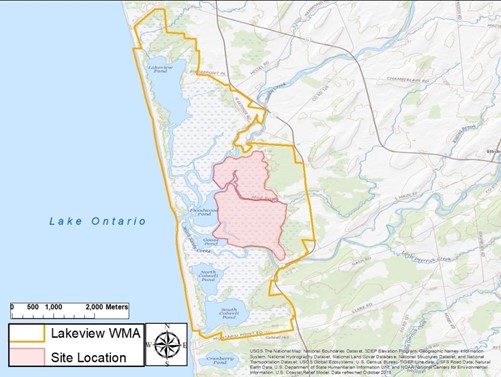Habitat Restoration in Priority Coastal Areas: Lakeview WMA
.
About Lakeview WMA Habitat Restoration
The Lakeview Wildlife Management Area is a 3,461-acre preserve in southern Jefferson County along the eastern shoreline of Lake Ontario and is managed by the New York State Department of Environmental Conservation (NYS DEC).
NOAA and the Great Lakes Commission are working with NYS DEC, Audubon New York, Audubon Great Lakes, and Ducks Unlimited to utilize a wetland enhancement technique knows as “channeling and potholing” to improve the hydrology, depth heterogeneity, interspersion of open water, and habitat connectivity to benefit spawning northern pike and other fish as well as breeding habitat for nesting Black Terns and migrating marsh birds and waterfowl.

More about Lakeview WMA Restoration
Lakeview WMA contains five large coastal ponds that are connected by numerous natural and manmade built channels. The wetlands at the site provide important spawning habitat for Northern pike, which are a keystone fish species as identified by the Great Lakes Action Plans, is the target species for this work. The site also supports many migrating, wintering and breeding bird species, including at-risk species such as the American Black Duck, Common Loon, Pied-billed Grebe, American Bittern, Black Tern, and Sedge Wren. Many wetland-dependent species use the area as a migratory staging and feeding area as well.
Due in part to artificial manipulation of water levels, the habitat at Lakeview WMA has been altered, becoming less diverse with increasing stands and mats of dense cattails and encroachment of invasive species. There is a need to create greater interspersion of open-water habitat and hemi-marsh conditions to restore historic habitat quality and improve coastal resilience to fluctuations in water levels associated with access to shallow water areas for fish spawning and nursery habitat. This project will utilize a wetland enhancement technique known as “channeling and potholing” to improve coastal marsh habitat so that it more closely resembles historic conditions prior to cattail invasion. These methods have been used elsewhere in Lake Ontario and other Great Lakes and monitoring has supported successful natural reproduction of young fish fry using the newly restored sites. The restoration will improve the hydrology, depth heterogeneity, interspersion of open water, and habitat connectivity to benefit spawning northern pike and other fish as well as breeding habitat for nesting Black Terns and migrating marsh birds and waterfowl.
Benefits of Restoration
Environmental Benefits:
- 180 acres of restored wetland habitat for fish and wildlife
- 5,000 linear feet of channels constructed through the marsh for spawning and nursery habitat of native fish species
- Dredging of 7 acres of open water to enhance habitat for fish and wildlife
Community Benefits:
- Improved wildlife viewing
- Improved fishing opportunities
- Controlled non-native vegetation
Economic Benefits:
- Improved sport fishing
Documents and Fact Sheets
The following fact sheet and documents provide additional information about the Lakeview WMA project and specific elements of the project.
News Coverage
- Creating new ponds to benefit fish, birds, recreation | February 2024
Project Partners
Chesterfield Township
Michigan Department of Natural Resources
National Oceanic and Atmospheric Administration
U.S. Environmental Protection Agency
Funding
Brandenburg Park has received over $890,000 in funding from the Great Lakes Restoration Initiative (GLRI) from both the U.S. Environmental Protection Agency and the National Oceanic and Atmospheric Administration and the NOAA Non-AOC Grant. GLRI is a federal program designed to protect and restore the largest system of fresh surface water in the world — the Great Lakes.
For More Information
Jill Estrada
Program Manager, Great Lakes Commission
734‐396‐6059
[email protected]
Andy Hinickle
Senior Manager, Wetland Conservation
Audubon Great Lakes
[email protected]
Sign up for our e-newsletter
Get the latest Great Lakes Commission news and events in your inbox!
Sign up for our e-newsletter
Get the latest Great Lakes Commission news and events in your inbox!

